| Please access the following URL if you want to secure using SSL. All pages in the site will be secure pages. |
https://secure02.blue.shared-server.net/www.fish-food.co.jp/message english 7.2024.html |
Welcome to FISH FOOD TIMES
Jul. 2024 issue No.247

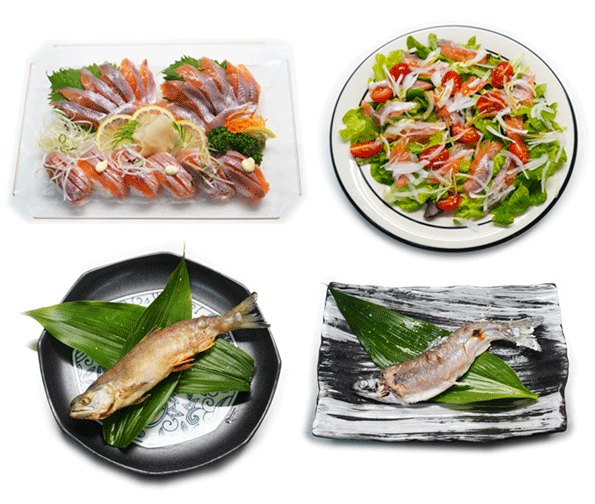
Natural Kokanee
Released fish with a long history
I got five Kokaneew fish caught in Lake Shikotsu in Hokkaido.
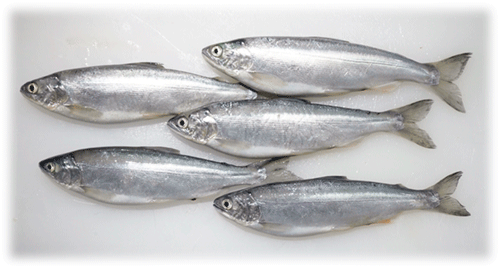
The whole thing was very beautiful, shining with a silvery white color, and I had a very good impression when I saw it. Even when I enlarged the image of one fish, she looked extremely fresh as shown below.

In the fish section of the supermarket I always use, there was a POP sign like the one below on display, and the fish were being sold naked in styrofoam boxes filled with ice water, with the selling price of 398 yen each.
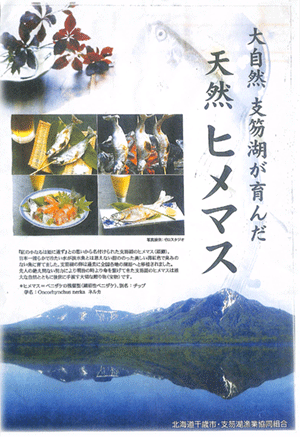
Kokanee came from Lake Shikotsu in Hokkaido and had been purchased through a fish market. As mentioned in POP, the author was first attracted by the label that it was natural, and was impressed by its reasonable size, reasonable price, and above all, its silvery white color and outstanding freshness.There was also an explanation that it could be used as sashimi. I received it so I decided to purchase it.
The sockeye salmon commonly found in fish sections is the same species as kokanee. Kokanee is distributed in the United States, Canada, Kamchatka, Hokkaido, etc., and refers to the lake-resident (landlocked) species that lives its entire life in lakes and ponds. On the other hand, sockeye salmon spawn in rivers that flow from the California coast to lakes and ponds in the North Pacific Ocean. The hatched fry enter the lakes and ponds and live there for 1 to 5 years before migrating down to the sea and living in the ocean for 1 to 3 years before migrating upstream to spawn.
The kokanee fish has a long history, having been first transplanted and released into Lake Shikotsu from Lake Akan in Hokkaido in 1894 (Meiji 27). Since then, attempts have been made to establish Kokanee in more than 60 lakes and ponds across the country, and they are now considered an important fishing resource in Lake Towada in Aomori Prefecture, Lake Toyako in Hokkaido, Lake Numazawa in Fukushima Prefecture, Lake Chuzenji in Tochigi Prefecture, Lake Ashinoko in Kanagawa Prefecture, Lake Saiko and Lake Motosu in Yamanashi Prefecture, and Lake Aoki in Nagano Prefecture.
In general, wild salmon and trout that grow in the sea may harbor parasites such as Japan Sea tapeworm (a type of tapeworm) and Anisakis, so to avoid food poisoning, wild salmon and trout should not be eaten. When eating raw fish, it is recommended to freeze it first and then use it as sashimi. However, kokanee are born in lakes and do not descend to the sea like sockeye salmon. As the proverb goes, "no fish can live in clear water," and they spend their entire lives in lakes where the water is too pure for other fish species to survive, there is no need to worry about the presence of parasites in kokanee, and they can be eaten raw without having to be frozen.
Freshness judgement
One of the purposes of acquiring the Kokanee this time was to eat them raw, but in fact, due to freshness issues, the first five fish were discarded and replaced with the newly arrived fish.
I bought my first 5 Kokanee fish on Saturday, but the internal organs were flowing without retaining their shape, and all the abdominal bones were floating outside the abdominal cavity, so I had to discard them during the process of removing their bellies. The second time, I went to the store early on Monday morning and was able to get the kokanee that had just arrived from the fish market that morning, without paying for it, by formally exchanging it for my Saturday stock.
| Kokanee freshness status | |
|---|---|
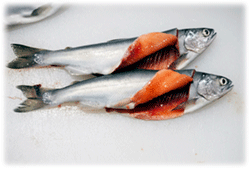 |
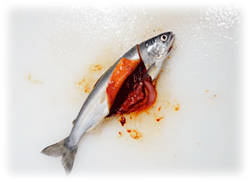 |
| 1st time | 2nd time |
However, as you can see in the image above, although the Kokanee I got the 2nd time was better than the one I got the 1st time, the internal organs were still misshapen and the abdominal bones were protruding.
So, the second time I cut open the kokanee's belly and smelled the internal organs, there was no rotten odor at all. My judgment was that this might be a weakness unique to freshwater fish, so I decided to disassemble the three pieces and assess the freshness.
I decided to use three of the five for raw consumption, so I did three pieces disassembling them. After removing the pin bones, they looked like this.
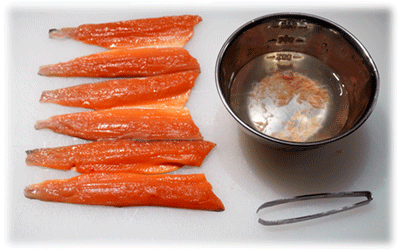
After removing the skin, it looked like this.
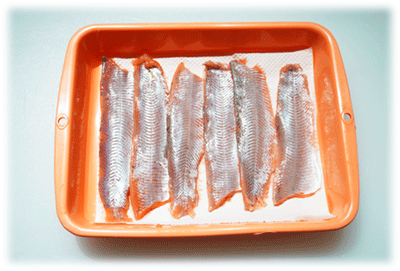
I decided that the fish could be eaten raw at this freshness level, so I decided to use one fish for sashimi, sushi, and salad.
The finished product is shown in the image below. For sashimi, I used half the fish, and made two piles of seven pieces of usutsukuri sashimi each, for a total of 14 pieces per fish. For sushi, I cut the half into three kan, for a total of six kan per fish.
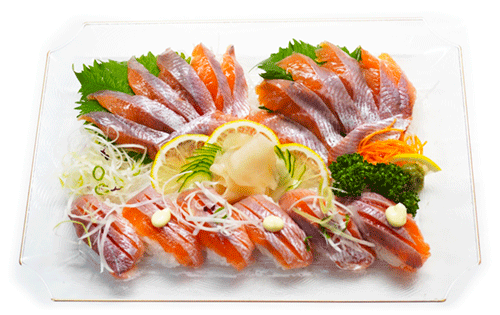
Next, for the salad, a whole kokanee is cut into 16 pieces and served with lettuce, sliced onions, and cherry tomatoes.
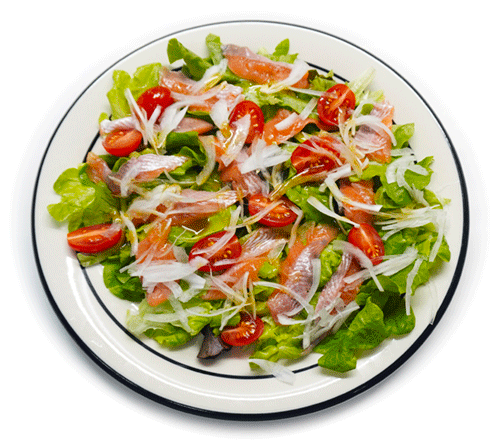
The above is the finished dish to be eaten raw, and it looks fine. Since I was starting out with concerns about the freshness of the kokanee I purchased, I now need to taste it to see if it will pass for eating raw.
As for me, based on my experience up to now, I have determined that it is possible to eat raw food when judging freshness using five senses such as smell, touch, and sight, excluding the final taste judgment using the tongue. In the end, I decided to try it and then make a decision.
The result was a "pass." It had the distinctive softness of raw salmon and wasn't chewy, but there was no strange odor and it was ripe and full of flavor for a fish of such small size. I was able to eat it all with enjoyment, and I didn't experience any symptoms such as stomach pain or diarrhea even the next day or later.
Grilled whole fish and deep-fried whole fish
The weight of the five kokanee ranged from 163g for the smallest to 216g for the largest, averaging about 180 to 200g.
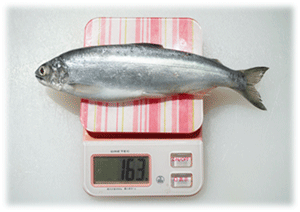
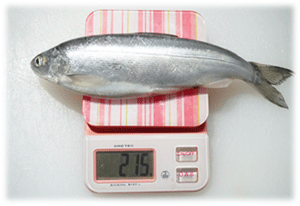
Since I used the three larger fish to eat raw, I decided to use the remaining two smaller fish to make grilled whole fish and deep-fried whole fish, taking advantage of their small size. First, I started by preparing the kokanee grilled whole fish and deep-fried whole fish.
| Preparation work for grilled whole fish and deep-fried whole fish | |
|---|---|
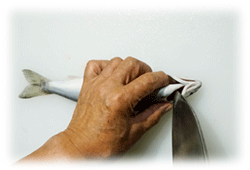 |
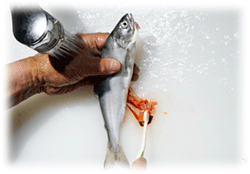 |
| 1,Press the flat part of the tip of the Deba knife onto the gills. | 6,Scrape out the internal organs from inside the abdominal cavity with a toothbrush. At that time, remove as many internal organs as possible while pouring water over them. |
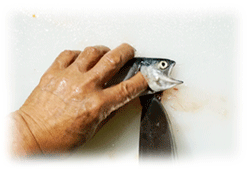 |
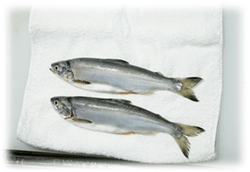 |
| 2,Using the flat part of the tip of the Deba knife, push the gills down onto the cutting board. | 7,Place the kokanee with gills and internal organs removed on a dry towel. |
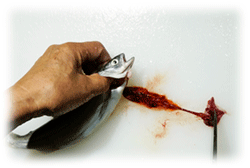 |
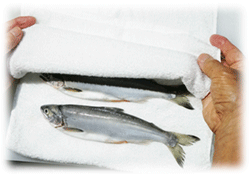 |
| 3,While holding the gills with a deba knife, shift the fish body to the left and separate the gills and some of the internal organs from the fish body. | 8,Place a dry towel over the kokanee. |
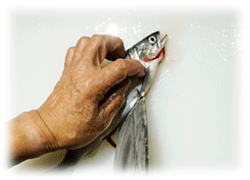 |
 |
| 4,Hold the deba knife like a reverse-handed knife and cut a few centimeters from the anus towards the head. | 9,Wrap the entire kokanee in a towel, pressing firmly especially around the abdomen to remove any moisture. |
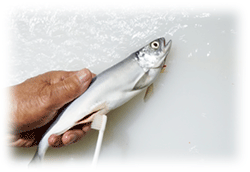 |
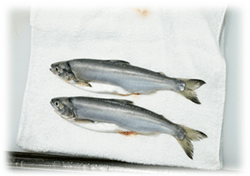 |
| 5,Insert the toothbrush into the abdominal cavity through the incision. | 10,We are now ready to do the kokanee grilled whole fish and deep-fried whole fish. |
After finishing the preparations for the kokanee dish, I started working on the skewering process. However, this did not turn out the way I expected. The kokanee is so soft that the tail fin doesn't stand up upwards, and instead falls to the side.
I tried several times to get the ideal shape, but eventually gave up and decided that I would be happy if I could express at least a little of the idea that "odorigushi is like a dancing fish," and that I would just let the two fish take their own course, depending on how they would fit on the grill and in the oil. Those who are used to skewering may find the result to be laughable, and I'm embarrassed to show this to my readers, but please bear with me.
| Kokanee's grilled whole fish and deep-fried whole fish production process | |
|---|---|
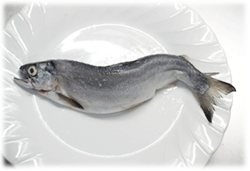 |
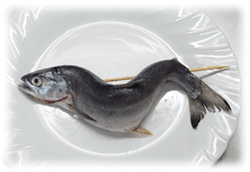 |
| 1,Skewer the fish using a flat metal skewer and sprinkle salt all over the fish. | 1,Skewer the fish using a bamboo skewer and sprinkle salt and pepper all over the fish. |
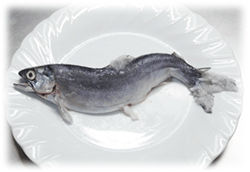 |
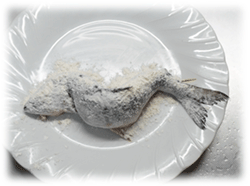 |
| 2,Apply cosmetic salt to each fin. | 2,Sprinkle the flour evenly over the entire fish. |
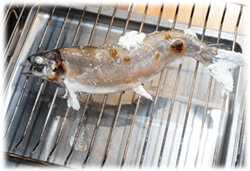 |
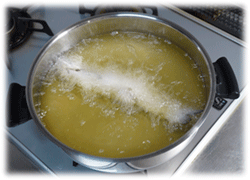 |
| 3,Finished grilling kokanee on the grill. | 3,Fry the kokanee in oil at a temperature of 180 degrees. |
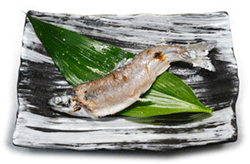 |
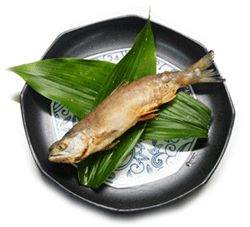 |
| 4,Remove the skewers, shake off the cosmetic salt, and serve on a plate and it's done. | 4,Remove the skewers while the fish is still warm, place it on a plate and it's done. |
When I tasted the finished kokanee grilled whole fish and deep-fried whole fish dishes, they tasted exactly like salmon or trout.
At home, the author basically eats "Salmon grilled'' every morning. What I buy is not a package of salmon containing two or three slices per pack, but rather about four bags a month of frozen sockeye or silver salmon, half a body in a vacuum bag. I cut this into fillets myself, wrap each piece in film, and store them in the freezer compartment of my refrigerator. Then, the day before I eat it, I transfer the required amount to the refrigerator to slowly defrost it, and then grill it the next morning and eat it almost every day.
As the author who continues to follow such eating habits, when I put my chopsticks into the kokanee grilled whole fish and deep-fried whole fish, I thought, ``Wow, it tastes just like the salmon I eat every morning...'' In other words, I found the taste to be familiar to me and thought that kokanee was a delicious fish.
Marine product logistics and 2024 issues
Thus, I was able to use up five kokanee in my cooking, but what was disappointing was that the inside of the abdominal cavity of the kokanee I had purchased was not particularly fresh. If the internal organs weren't misshapen and the abdominal bones weren't sticking out of the abdominal cavity, the taste of kokanee would have been so good that it would have been rated higher, but all I can say is that it's a shame.
When I first bought Kokanee on Saturday, I was so disappointed with its condition that I immediately threw it away. I also confirmed that the kokanee I purchased on my second visit had just arrived at the store from the fish market on Monday, and the freshness was not much different from the one I bought on Saturday. In other words, it has been proven that the deterioration in freshness is not due to kokanee being stored for a long time in the store.
Also, on Saturday, I contacted the store with a message with an image showing the freshness of the kokanee. It seems that the fish market has also been informed of this by the store, so I believe that the fish market must be taking measures based on this series of events. Based on this premise, the next question that arises is how many days it took for the goods to transport from Hokkaido to Kyushu, which is the previous step.
From April 2024, the upper limit on overtime hours for drivers will be capped at 960 hours, and laws related to work style reform will become mandatory in the logistics industry. And I think it's not inconceivable that one of the reasons is that they haven't been able to adequately respond to this issue.
Under the new Work Style Reform Act, truck drivers are required to take a 30-minute break for every four hours of driving, and there are now cases where two drivers are required to transport in relay format, even for distances that they previously were able to drive alone without any problems. If transport is to be carried out with breaks in between or in a relay format, the transportation time will be longer than before, and there are concerns that transportation costs will increase due to increased labor costs.
In addition, transportation of seafood has its own unique circumstances at fish markets, such as ``shipment quantities are not confirmed until the last minute'' and ``unloading time at fish markets is long.''Currently, most of the transportation of marine products relies on truck transportation, and the longer it takes for fish to be transported, the greater the risk of the fish becoming less fresh or not being delivered in time for auction.
For example, even if fishermen try to send fresh seafood from production areas in Hokkaido or Kyushu to urban areas, if they cannot find an effective method, there is a risk that the freshness of the fish will decrease, and if the fish loses its freshness, they may not be able to compete properly with rival businesses. This risk becomes more pronounced the greater the distance between production areas and major urban consumption areas, such as in Hokkaido and Kyushu.
The kokanee I handled this time was from Lake Shikotsu in Hokkaido. We can only guess when the fish left Hokkaido, what route it took, and what main means of transportation it used to get to Kyushu. However, I suspect that most of the transportation was by truck.
Kokanee was born and raised around Lake Shikotsu, which is filled with beautiful, pure water, so it is a real shame that it cannot show its true form. I really wanted to write about the kokanee I dealt with this time in the July 2024 issue of FISH FOOD TIMES, so I proceeded with the cooking process a little aggressively and made sashimi, sushi, and salad. However, if an ordinary person who did not have much experience in determining freshness had looked at the state of the inside of the abdominal cavity of this kokanee in the same way as raw mackerel, he would not have had the courage to make it into sashimi.
As a result, I was able to eat kokanee in sashimi, sushi, and salad without any problems, and I did not experience any physical abnormalities afterward, so the freshness of the food was acceptable for raw consumption. However, if Hokkaido producers intend to steadily sell kokanee produced in Lake Shikotsu in Kyushu in the future, I think they will need to take measures to improve the current logistics issues.
I think there are several options for how to deal with this issue, but I would like to close this month's issue by writing down some recently released hot information below for your reference.
JAL has announced that it will enhance its air-ground integrated transportation service "HakoJET" in collaboration with Roofe Co., Ltd., and launch a new delivery service called "J-AIR Direct Fresh Service" on June 17th, specializing in transporting local specialty products while maintaining their freshness.
Until now, when using air cargo transport, it was necessary to make separate arrangements for air transport and ground transport. This transportation method will enable "air-land integrated logistics" that connects JAL's domestic flight network with Roofee's shippers, and will provide new value in the form of Japan's first same-day delivery matching service for three temperature zones that allows customers to specify the time even over long distances. The specific image posted on the J-AIR website is as shown in the figure below.
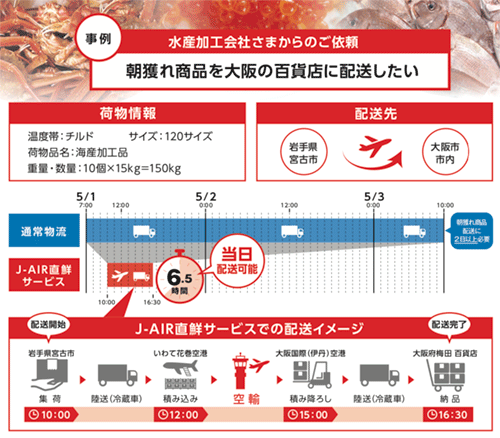
The terms of use for the J-AIR Direct Fresh service are as follows:
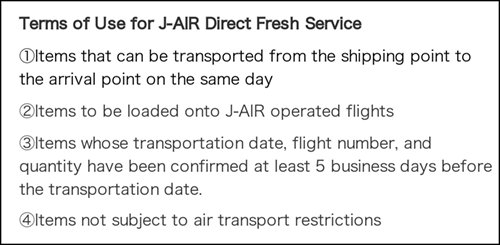
As for the actual shipping costs, they are likely to vary depending on the shipper's products and volume, so it is difficult to state them here. I have some doubts as to whether kokanee, which was sold for 398 yen per fish, can meet the shipping cost of this direct fresh service, but I would like to record this as the latest information for now.
I look forward to the day when I will be able to handle kokanee sent from Hokkaido while still being extremely fresh.
| Please access the following URL if you want to secure using SSL. All pages in the site will be secure pages. |
https://secure02.blue.shared-server.net/www.fish-food.co.jp/message english 7.2024.html |
An opinion and the communication are to iinfo@fish food times
Date of updating 1 Jul. 2024
